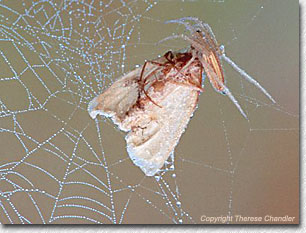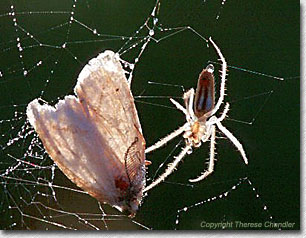|
|
 Feature Article... Meadow's Classroom
Text Copyright and Photography Copyright Therese Chandler As an elementary school teacher, I am used to being the educator and creating the lesson plan. But as a nature photographer I discovered the roles are reversed. On a recent photography outing, while kneeling in an overgrown meadow, Nature was the teacher and I was the one I attending school. And she taught me four valuable lessons that day. I absolutely enjoy photographing in dew-laden conditions because one can often find small, inactive insects or spiders. This is marvelous for macro work since these creatures are relatively immobile until the sun and wind to dry their bodies. This allows one a detailed view of these fascinating animals! And that is why I rose at 4:20 one early morning, in anticipation of nice carpet of dew, to venture out to Brazos Bend State Park and photograph insects. Arriving at the park, I observed little moisture on the meadows and I quickly became disappointed and frustrated.
Lesson One: Light changes! To spot meter this scene, I had to continuously recheck and meter my middle tone to make sure it is still medium. I will usually meter middle tone and let the other exposure values fall as they will, but in this case, when the backlighting was most dramatic, I metered the arachnid’s body (middle tone) and closed down half a stop to emphasize this shimmering light. In macro work depth of field is extremely limited, so one must concentrate intently on adjusting the film plane to be parallel to your subject. That way, most or the all of the subject is sharp. At the apex of this glowing light, I observed total glare in the viewfinder. My brain went numb! “I’m can’t readjust the camera, or it won’t be parallel!” But then I saw the dreaded hexagonal shape creeping into the viewfinder. I decided to point the camera slightly downward and recapture my lovely, dark, green background. Lesson Two: Sometimes you have to break the rules to make the shot work!
Lesson Three is one I will always have to improve upon- STAY PATIENT! While photographing this scene, I encountered intermittent winds and a very active spider! Many times I had everything metered and focused, and the wind or the hungry arachnid moved the web. I decided to be patient and not give up. I used three rolls of film for this shoot, more than I would normally sacrifice. But this backlit spider consuming breakfast was an incredible moment that I wanted to capture despite the obstacles! Which brings me to Lesson Four: Stick with a potentially great subject. The grass is not always greener on the other side! When this scenario first caught my attention, I was very skeptical. I am glad to say that the rational part of my photographic brain made me retreat back to the tiny Orb Weaver’s web. There were many occasions, especially in telephoto work, that I displayed pure impatience, and most certainly bypassed wonderful opportunities for nature photography. While driving back home that day, I reflected on the four lessons learned in the Meadow: Light can be ever changing. Sometimes rules must be broken. Stay patient. Stick with a subject if you know it could have great potential. As a developing amateur nature photographer, I realize the value of these lessons and that I must strive to not only to remember them, but to implement them in the field as well! Tech Data Image 1 (Orb Weaver Spider) - Brazos Bend State Park, 6:45 a.m. , Minolta 800, Minolta 200mm Macro Lens, Gitzo 1228 Tripod, Cable Release, Fujichrome Provia F, Natural Lighting, no filter used, f/16, metered spider's abdomen with no changes. Image 2 (Orb Weaver Spider) - Brazos Bend State Park (TX), 7:30 a.m. , Minolta 800, Minolta 200mm Macro Lens, Gitzo 1228 Tripod, Cable Release, Fujichrome Provia F, f/16, Natural Lighting, no filter used, metered spider's abdomen and closed down 1/2 stop. |
|
|
 Wandering the meadow, a small spider and an entangled moth caught my attention. “That spider is way too small,” I thought. I decided to take a few record shots anyway, but I was anxious to find something better. As I walked away, my mind kept telling me to go back to the tiny arachnid. Lowering my tripod again, trying to get the film plane parallel with the subject, I noticed that this Orb Weaver was glowing in a marvelous backlight! I was amazed at the varying nuances of the light.
Wandering the meadow, a small spider and an entangled moth caught my attention. “That spider is way too small,” I thought. I decided to take a few record shots anyway, but I was anxious to find something better. As I walked away, my mind kept telling me to go back to the tiny arachnid. Lowering my tripod again, trying to get the film plane parallel with the subject, I noticed that this Orb Weaver was glowing in a marvelous backlight! I was amazed at the varying nuances of the light.